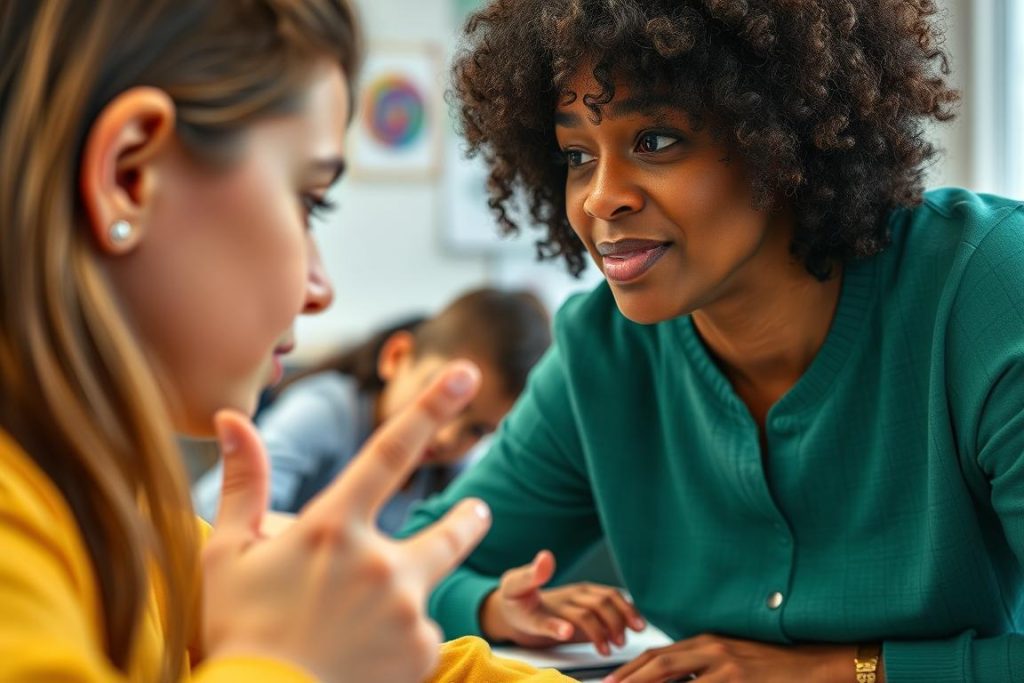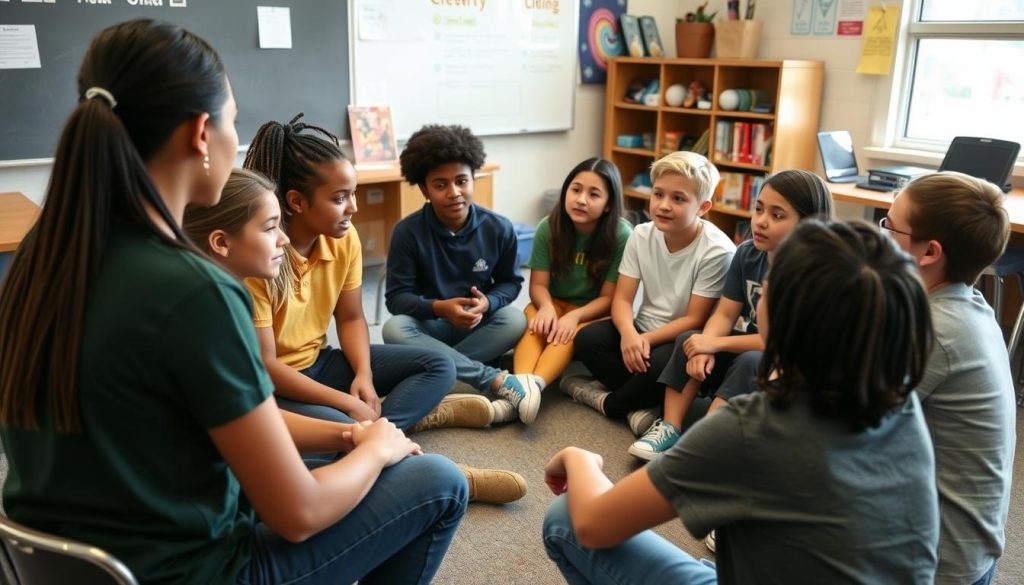In this comprehensive guide, we’ll explore 25 practical classroom discipline strategies that you can implement immediately. These approaches have been tested by educators across grade levels and can be adapted to suit your unique teaching style and student needs. Let’s dive in and discover how to transform your classroom management with these proven teacher skills.
Understanding the Importance of Effective Classroom Strategies
Before diving into specific techniques, it’s important to understand why Effective Classroom Strategies matter. According to a 2023 Pew Research Center survey, nearly half of teachers describe student behavior as poor or fair. Additionally, classroom management challenges are cited as a leading cause of teacher burnout and attrition.
Effective discipline isn’t about punishment—it’s about creating a structured environment where learning can flourish. When you master essential teacher skills related to classroom management, you’ll experience:
- Increased instructional time as less is spent addressing disruptions
- Improved student achievement and engagement
- Better teacher-student relationships
- Reduced stress and teacher burnout
- A positive classroom culture that promotes social-emotional growth
The most successful educators view classroom management as a set of teacher skills that can be developed and refined over time. By implementing the right combination of Effective Classroom Strategies, you can create an environment where students feel safe, respected, and motivated to learn.
Ready to Transform Your Classroom Management?
Discover professional development opportunities designed specifically for teachers looking to enhance their classroom management skills.
Proactive Effective Classroom Strategies
The most successful classroom managers don’t just react to problems—they prevent them. These proactive strategies help establish a positive classroom environment from day one.
1. Establish Clear Expectations
Students thrive when they understand what’s expected of them. Developing clear, specific classroom rules and procedures is one of the most fundamental teacher skills. Research consistently shows that classrooms with well-established expectations experience fewer disruptions.
Effective implementation includes:
- Limiting rules to 3-5 key expectations that are positively phrased
- Involving students in creating classroom expectations
- Posting rules visibly in the classroom
- Reviewing expectations regularly, not just at the beginning of the year
2. Design an Engaging Physical Environment
Your classroom layout can significantly impact student behavior. Thoughtful arrangement of furniture, materials, and visual elements can minimize distractions and promote focused learning.
Consider these environmental factors:
- Arrange desks to minimize traffic problems and maximize visibility
- Create designated areas for different activities (quiet reading, group work)
- Ensure materials are organized and accessible
- Use visual cues and signals to guide behavior
3. Build Positive Relationships
Perhaps the most powerful preventative strategy is building strong, positive relationships with students. When students feel connected to their teacher, they’re more likely to cooperate and engage in learning.
Relationship-building teacher skills include:
- Greeting students by name at the door each day
- Learning about students’ interests and incorporating them into lessons
- Using a ratio of at least 3:1 positive to negative interactions
- Taking time for brief personal conversations with each student regularly
4. Implement Consistent Routines
Predictable routines reduce anxiety and behavior problems while maximizing learning time. Effective teachers establish clear procedures for everything from entering the classroom to transitioning between activities.
Essential routines to establish:
- Morning entry and afternoon dismissal
- Transitions between subjects or activities
- Obtaining help when the teacher is busy
- Using classroom materials and technology
- Emergency procedures
5. Use Engaging Instructional Strategies
Many behavior problems stem from boredom or frustration with instruction. By implementing engaging, differentiated teaching approaches, you can prevent many discipline issues before they start.
Effective instructional teacher skills include:
- Incorporating movement and hands-on activities
- Using technology purposefully to enhance learning
- Providing choice in assignments and activities
- Differentiating instruction to meet diverse learning needs
- Connecting content to real-world applications
Responsive Effective Classroom Strategies
Even with excellent prevention, all teachers will face behavioral challenges. These responsive strategies help address problems effectively while maintaining a positive classroom culture.
6. Use Proximity Control
Simply moving closer to a student who is off-task or disruptive can often redirect behavior without interrupting instruction. This subtle technique is one of the most versatile teacher skills for managing minor disruptions.
Implementation tips:
- Move throughout the classroom during instruction rather than staying in one spot
- Position yourself near potential problem areas during independent work
- Use proximity in combination with nonverbal cues like eye contact
- Avoid hovering or creating tension with your presence
7. Employ Nonverbal Cues
Nonverbal signals allow you to address behavior without disrupting the flow of instruction. These subtle interventions can redirect students while maintaining their dignity.
Effective nonverbal strategies:
- Establish hand signals for common needs (bathroom, water, help)
- Use facial expressions to communicate approval or concern
- Implement attention signals for the whole class (chimes, lights)
- Develop private signals with individual students who need frequent reminders

8. Redirect Behavior Positively
When students misbehave, positive redirection focuses on the desired behavior rather than the problem. This approach maintains a constructive atmosphere while guiding students back on track.
Redirection techniques:
- State what students should do rather than what they shouldn’t
- Offer choices between acceptable alternatives
- Use “when/then” statements (“When you complete your paragraph, then you can choose a center activity”)
- Remind students of class expectations in a neutral tone
9. Implement Logical Consequences
When redirection isn’t sufficient, logical consequences help students understand the impact of their choices. Unlike punishment, logical consequences are related to the behavior, reasonable in scope, and delivered respectfully.
Examples of logical consequences:
- If a student misuses materials, they lose access to those materials temporarily
- If work isn’t completed during class time due to off-task behavior, it becomes homework
- If a student disrupts group work, they complete the assignment independently
- If property is damaged, the student helps repair or replace it
10. Use Private Conversations
Addressing behavior issues privately preserves student dignity and prevents power struggles. Brief, calm conversations away from peers can resolve many problems effectively.
Guidelines for private conversations:
- Speak in a neutral, calm tone
- Focus on the specific behavior, not the student’s character
- Listen to the student’s perspective
- Collaborate on solutions going forward
- End on a positive note that preserves the relationship
Master Effective Discipline Techniques
Take your classroom management to the next level with our comprehensive discipline resources designed specifically for K-12 teachers.
Reinforcement Effective Classroom Strategies
Reinforcing positive behavior is just as important as addressing problems. These strategies help create a classroom culture where good behavior is the norm.
11. Implement Positive Reinforcement
Acknowledging and rewarding desired behaviors increases the likelihood they’ll be repeated. Effective teachers use a variety of reinforcement approaches to motivate students.
Reinforcement strategies:
- Provide specific, descriptive praise (“I noticed how you helped your classmate understand the problem—that shows great teamwork”)
- Use tangible rewards sparingly and unexpectedly
- Implement class-wide reward systems for collective improvement
- Personalize reinforcement based on what motivates individual students
12. Create a Token Economy
Token economies provide a structured system for reinforcing positive behavior. Students earn tokens for meeting expectations, which can later be exchanged for privileges or rewards.
Implementation tips:
- Clearly define behaviors that earn tokens
- Offer a variety of rewards at different “price points”
- Make earning tokens achievable for all students
- Gradually reduce external rewards as internal motivation develops
13. Use Behavior Contracts
For students who need additional support, individual behavior contracts provide clear expectations and consequences. These written agreements help students take ownership of their behavior.
Elements of effective contracts:
- Specific, observable behaviors to increase or decrease
- Clear rewards for meeting goals
- Logical consequences for not meeting expectations
- Signatures from the student, teacher, and possibly parents
- Regular review and adjustment as needed
14. Implement Class-Wide Systems
Class-wide behavior systems create a sense of community and shared responsibility. These approaches motivate students to work together toward common goals.
Effective class systems:
- Group contingency programs where the whole class works toward a celebration
- Class points or tallies that can be earned (or lost) based on collective behavior
- Classroom jobs that give students responsibility and ownership
- Peer recognition programs where students acknowledge each other’s positive behaviors
15. Provide Regular Feedback
Consistent feedback helps students understand their progress and areas for growth. Both formal and informal feedback mechanisms support behavioral development.
Feedback approaches:
- Daily or weekly behavior reports for individual students
- Class meetings to discuss collective progress
- Self-assessment opportunities for students to reflect on their behavior
- Positive notes or calls home to reinforce improvements
Teaching Self-Regulation Through Effective Classroom Strategies
The ultimate goal of classroom management is to help students develop self-discipline. These strategies focus on building students’ capacity to regulate their own behavior.
16. Teach Social-Emotional Skills Explicitly
Many behavior problems stem from underdeveloped social-emotional skills. Explicit instruction in these areas is an essential component of effective classroom management.
Key skills to teach:
- Identifying and managing emotions
- Conflict resolution and problem-solving
- Active listening and communication
- Empathy and perspective-taking
- Stress management and self-regulation
17. Use Restorative Practices
Restorative approaches focus on repairing harm and rebuilding relationships rather than punishment. These practices help students take responsibility for their actions and make amends.
Restorative techniques:
- Restorative circles to address classroom conflicts
- Structured conversations between students in conflict
- Collaborative problem-solving to address recurring issues
- Community-building activities to strengthen relationships

18. Implement Mindfulness Practices
Mindfulness techniques help students develop awareness and self-regulation skills. Regular practice can reduce impulsivity and improve focus.
Classroom mindfulness activities:
- Brief breathing exercises at transition times
- Guided visualization for stress reduction
- Body scans to increase self-awareness
- Mindful movement breaks during instruction
19. Create Calm-Down Spaces
Designated areas where students can go to regulate their emotions provide an alternative to disruptive behavior. These spaces teach students to recognize when they need a break.
Elements of effective calm-down spaces:
- Comfortable seating in a semi-private area
- Sensory tools like stress balls or fidgets
- Visual cues for calming strategies
- Timer to encourage appropriate use
- Clear procedures for using the space
20. Teach Executive Functioning Skills
Many behavior problems stem from underdeveloped executive functions like planning, organization, and impulse control. Explicit instruction in these areas supports better self-regulation.
Strategies for building executive functions:
- Visual schedules and checklists
- Graphic organizers for planning tasks
- “Stop and think” routines before acting
- Self-monitoring tools for tracking behavior
- Breaking complex tasks into manageable steps
Enhance Your Teacher Skills
Access professional development opportunities that will help you master classroom management and create a positive learning environment.
Strategies for Challenging Behaviors
Some students require more intensive support. These strategies address persistent or severe behavior challenges.
21. Conduct Functional Behavior Assessments
Understanding the function or purpose of challenging behavior is essential for effective intervention. Functional behavior assessment (FBA) is a systematic process for identifying behavior triggers and maintaining factors.
FBA process:
- Define the behavior in observable terms
- Collect data on when, where, and with whom the behavior occurs
- Identify antecedents (what happens before) and consequences (what happens after)
- Develop hypotheses about the function of the behavior
- Design interventions based on the function
22. Implement Behavior Intervention Plans
Based on FBA results, behavior intervention plans (BIPs) provide individualized support for students with persistent challenges. These plans include prevention strategies, replacement behaviors, and response protocols.
BIP components:
- Prevention strategies to reduce triggers
- Teaching replacement behaviors that serve the same function
- Reinforcement systems for appropriate behavior
- Crisis response procedures for serious incidents
- Data collection methods to monitor progress

23. Use Check-In/Check-Out Systems
For students who need daily structure and feedback, check-in/check-out (CICO) systems provide regular touchpoints throughout the day. This approach combines accountability with positive adult relationships.
CICO implementation:
- Morning check-in with a designated staff member to set daily goals
- Point card or rating sheet that travels with the student
- Brief feedback from teachers after each class period or activity
- End-of-day check-out to review progress and celebrate successes
- Home-school communication component
24. Collaborate with Support Staff
For students with significant behavioral needs, collaboration with specialists is essential. School counselors, psychologists, and behavior interventionists can provide valuable expertise and resources.
Collaborative approaches:
- Regular team meetings to discuss student progress
- Shared responsibility for implementing interventions
- Consistent communication about what works
- Professional development to build teacher skills in specific areas
- Wraparound services that address needs beyond the classroom
25. Partner with Families
Family engagement is crucial for addressing challenging behaviors. When school and home work together, interventions are more likely to succeed.
Family partnership strategies:
- Regular, positive communication about student progress
- Home-school behavior plans with consistent expectations
- Parent training in effective strategies
- Celebration of improvements, no matter how small
- Cultural sensitivity in all interactions
Implementing Effective Classroom Strategies Successfully
Knowing strategies is only the first step—successful implementation requires planning, consistency, and ongoing adjustment. Here’s how to put these approaches into practice effectively.
Start Small and Build
Trying to implement too many new strategies at once can be overwhelming. Begin with 2-3 approaches that address your most pressing needs, then gradually add more as these become routine.
Be Consistent
Consistency is perhaps the most important factor in successful classroom management. Students need to know that expectations and consequences remain the same from day to day.
Reflect and Adjust
Regularly evaluate the effectiveness of your strategies and be willing to make changes. What works for one group of students may not work for another.
Practice Self-Care
Effective classroom management requires patience and emotional regulation. Prioritize your own well-being to maintain the energy and positivity needed for consistent implementation.
Ready to Transform Your Classroom?
Discover comprehensive resources for implementing effective discipline strategies in your classroom.
Conclusion: Building Your Classroom Management Toolkit
Effective classroom management is both an art and a science. The 25 strategies outlined in this guide provide a comprehensive toolkit for addressing behavior challenges while creating a positive learning environment. Remember that developing strong teacher skills in classroom management is an ongoing process that requires patience, consistency, and a willingness to learn.
As you implement these Effective Classroom Strategies, focus on building relationships, teaching expectations explicitly, and reinforcing positive behavior. With time and practice, you’ll create a classroom where students feel safe, respected, and ready to learn.
The most successful teachers view classroom management not as a way to control students, but as a means of empowering them to develop self-discipline and responsibility. By implementing these research-backed strategies consistently, you’ll not only reduce behavior problems but also create a more joyful and productive learning environment for everyone.
Continue Your Professional Growth
Access additional resources, courses, and support to enhance your teacher skills and create a positive classroom environment.




